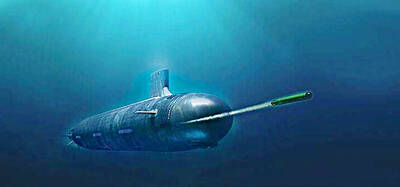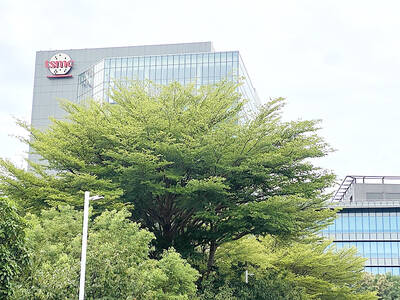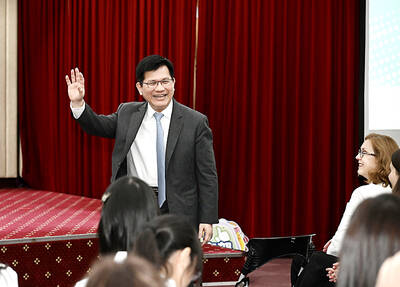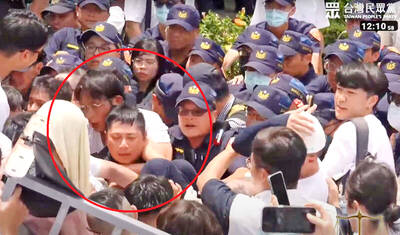Taiwan’s latest national defense report highlights an increasing military threat from China, saying that Beijing plans to boost its combat capabilities to the point at which it could mount a full cross-strait attack.
China’s combat capabilities are expected to reach that level in 2020, according to the 12th National Defense Report released by the Ministry of National Defense at a press conference yesterday.
The report said China has been developing and deploying various types of new high-end weapons, as well as advanced cyberattack and defense technologies.
China also plans to ramp up its combat capabilities to the level where it could launch an all-out attack on Taiwan, including on outlying islands, the report said.
“Combined operations” remain the Chinese People’s Liberation Army’s basic combat model and its military modernization is aimed at developing a credible deterrent to any third-party intervention in a possible conflict with Taiwan, the report said.
For example, China’s deployment of the Dong Feng 21D anti-ship ballistic missile, the so-called “aircraft carrier-killer,” is aimed at hitting US aircraft carriers, said Cheng Yun-peng (成雲鵬), director-general of the ministry’s Department of Strategic Planning.
Cheng said that the 2020 timeframe is a rough estimate, but that China was making major advances in its arsenal.
In the face of the military imbalance skewed in China’s favor, Taiwan’s military is adhering to a concept of innovative, asymmetric warfare, in line with national defense policies, Cheng said at the news conference.
In an effort to maintain adequate self-defense capabilities, Taiwan is developing its own weapons and is also seeking to purchase arms from other countries, he added.
Currently, Taiwan’s indigenous Hsiung Feng III anti-ship missiles — developed by the Chungshan Institute of Science and Technology — have the ability to counter the threat of Chinese amphibious and aircraft carrier attacks, Cheng said.
In terms of jet fighters, Taiwan needs more advanced aircraft than its existing fleet of F-16A/Bs, which are currently being upgraded with the help of the US, Cheng said.
Military analysts say that China has at least 1,600 ballistic missiles aimed across the Taiwan Strait.
Despite the potential military threat, Taiwan is cutting its own defense spending, with the number of active-duty soldiers due to be reduced to 215,000 next year from the current 240,000.
The report also covered other issues, such as the military’s 13 proposed reforms, which focus on ensuring human rights, making sure service members have a channel for filing complaints and reporting abuses, and reviewing disciplinary confinement regulations.
The reform drive is also meant to improve administrative procedures for disciplinary confinement and the facilities that military personnel are confined in, as well as establishing reasonable punitive exercises for detainees, the report said.
The focus on a complaint mechanism and confinement was a direct response to the death of army corporal Hung Chung-chiu (洪仲丘), who died in July while serving his mandatory military service due to heat exhaustion allegedly caused by intensive training administered while in detention.
The incident sparked a public outcry, prompted the resignation of then-minister of defense Kao Hua-chu (高華柱) and led the government to pass legislation to turn over military trials to civilian courts during peacetime.
Additional reporting by AFP

FIREPOWER: On top of the torpedoes, the military would procure Kestrel II anti-tank weapons systems to replace aging license-produced M72 LAW launchers Taiwan is to receive US-made Mark 48 torpedoes and training simulators over the next three years, following delays that hampered the navy’s operational readiness, the Ministry of National Defense’s latest budget proposal showed. The navy next year would acquire four training simulator systems for the torpedoes and take receipt of 14 torpedoes in 2027 and 10 torpedoes in 2028, the ministry said in its budget for the next fiscal year. The torpedoes would almost certainly be utilized in the navy’s two upgraded Chien Lung-class submarines and the indigenously developed Hai Kun, should the attack sub successfully reach operational status. US President Donald Trump

Taiwan Semiconductor Manufacturing Co (TSMC, 台積電) is expected to start construction of its 1.4-nanometer chip manufacturing facilities at the Central Taiwan Science Park (CTSP, 中部科學園區) as early as October, the Chinese-language Liberty Times (the Taipei Times’ sister newspaper) reported yesterday, citing the park administration. TSMC acquired land for the second phase of the park’s expansion in Taichung in June. Large cement, construction and facility engineering companies in central Taiwan have reportedly been receiving bids for TSMC-related projects, the report said. Supply-chain firms estimated that the business opportunities for engineering, equipment and materials supply, and back-end packaging and testing could reach as high as

ALL QUIET: The Philippine foreign secretary told senators she would not respond to questions about whether Lin Chia-lung was in the country The Ministry of Foreign Affairs on Wednesday confirmed that a business delegation is visiting the Philippines, but declined to say whether Minister of Foreign Affairs Lin Chia-lung (林佳龍) is part of the group, as Philippine lawmakers raised questions over Lin’s reported visit. The group is being led by Deputy Minister of Agriculture Huang Chao-chin (黃昭欽), Chinese International Economic Cooperation Association (CIECA) chairman Joseph Lyu (呂桔誠) and US-Taiwan Business Council (USTBC) vice president Lotta Danielsson, the ministry said in a statement. However, sources speaking on condition of anonymity said that Lin is leading the delegation of 70 people. Filinvest New Clark City Innovation Park

TPP RALLY: The clashes occurred near the Chiang Kai-shek Memorial Hall on Saturday at a rally to mark the anniversary of a raid on former TPP chairman Ko Wen-je People who clashed with police at a Taiwan People’s Party (TPP) rally in Taipei on Saturday would be referred to prosecutors for investigation, said the Ministry of the Interior, which oversees the National Police Agency. Taipei police had collected evidence of obstruction of public officials and coercion by “disorderly” demonstrators, as well as contraventions of the Assembly and Parade Act (集會遊行法), the ministry said in a statement on Sunday. It added that amid the “severe pushing and jostling” by some demonstrators, eight police officers were injured, including one who was sent to hospital after losing consciousness, allegedly due to heat stroke. The Taipei